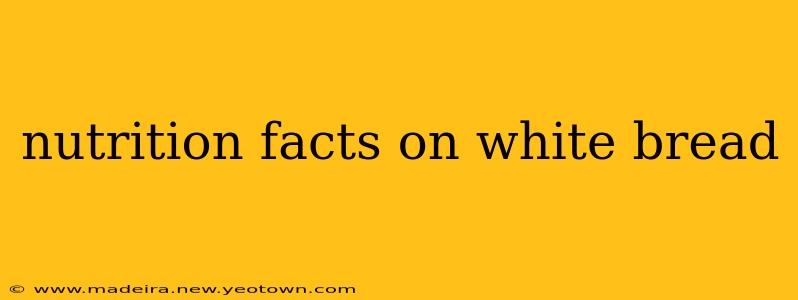White bread. A staple in many pantries, a lunchtime companion, a toast-of-the-morning. But what exactly is in that seemingly simple slice? Let's go beyond the basic nutritional label and explore the nutritional facts of white bread, addressing some common questions along the way.
What are the main nutritional components of white bread?
White bread, at its core, is made from refined wheat flour, water, yeast, and often salt and sugar. This simple composition, however, results in a surprisingly complex nutritional profile. A typical slice (around 1 ounce or 28 grams) offers a moderate amount of carbohydrates, primarily in the form of starch. It provides a small amount of protein, mostly from the wheat itself, and trace amounts of fat. While not a significant source of vitamins and minerals compared to whole-grain options, white bread is often fortified with things like iron and B vitamins, boosting its nutritional value somewhat. The exact amounts vary depending on the brand and specific recipe.
How many calories are in a slice of white bread?
This is a question with a variable answer. A single slice of white bread typically contains between 70-80 calories. However, factors like the size of the slice, the type of flour used (some brands may use slightly different flour blends), and added ingredients like sweeteners or oils can influence the final calorie count. Always check the nutrition label on the specific package you're consuming for the most accurate information.
Is white bread high in carbs?
Yes, white bread is relatively high in carbohydrates. These carbs are mainly simple starches, which are quickly digested and absorbed into the bloodstream, leading to a rapid rise in blood sugar levels. This quick sugar rush is why white bread often gets a bad reputation. However, it's important to remember that carbohydrates are a necessary part of a balanced diet, providing the body with energy. The issue lies more in the type of carbohydrate and the overall context of the diet. Choosing whole-wheat bread, which contains more fiber and complex carbohydrates, can lead to a slower, more sustained release of energy and better blood sugar control.
Does white bread contain fiber?
While refined white bread contains significantly less fiber than whole-grain bread, it still has some fiber. The amount varies depending on the brand and processing methods, but typically, a slice will contain only a gram or two of fiber, a relatively small amount compared to the recommended daily intake. The refining process removes much of the bran and germ, which are the parts of the wheat kernel richest in fiber.
What are the downsides of eating white bread?
The primary downside of consuming too much white bread is its impact on blood sugar levels. The high glycemic index (GI) of white bread can lead to spikes in blood sugar, followed by crashes, potentially contributing to weight gain, increased hunger, and even long-term health issues like type 2 diabetes if consumed excessively as part of an overall unhealthy diet. The low fiber content also means it provides less satiety than whole-grain alternatives, possibly contributing to overeating. Furthermore, the lack of essential nutrients in comparison to whole-wheat bread is a concern.
What are some healthier alternatives to white bread?
Fortunately, there are many healthier alternatives to white bread. Opting for whole-wheat bread is a significant improvement, as it offers considerably more fiber, vitamins, and minerals. Other healthy alternatives include sourdough bread (often easier to digest), rye bread, and various gluten-free options made from grains like quinoa or oats. Ultimately, variety and moderation are key to a healthy diet.
This exploration into the nutritional facts of white bread highlights the importance of understanding the impact of food choices on our bodies. While white bread can certainly be enjoyed in moderation, being mindful of its nutritional profile and exploring healthier alternatives can contribute significantly to overall well-being. Remember to always check the specific nutrition label on the product you are consuming for the most accurate information.

